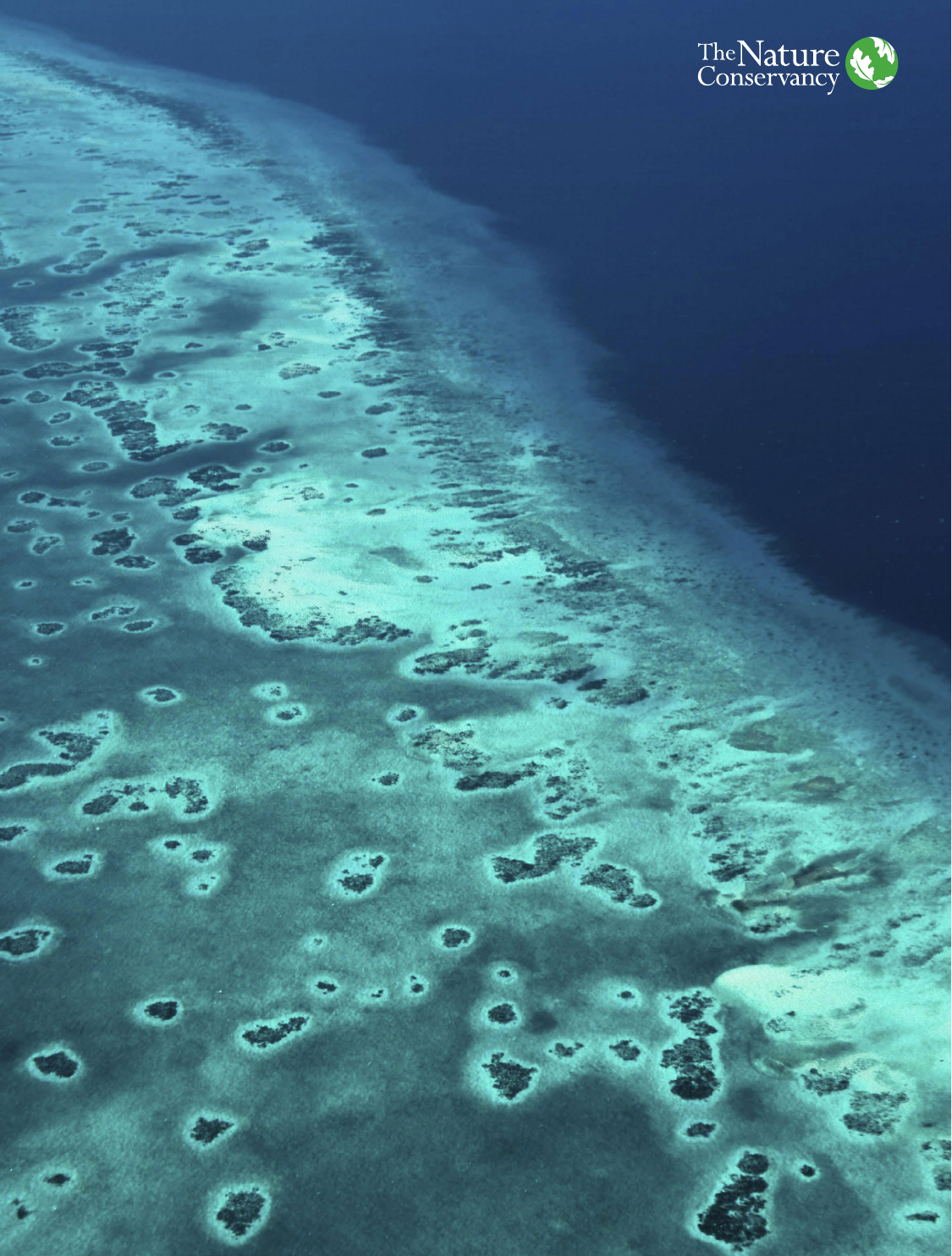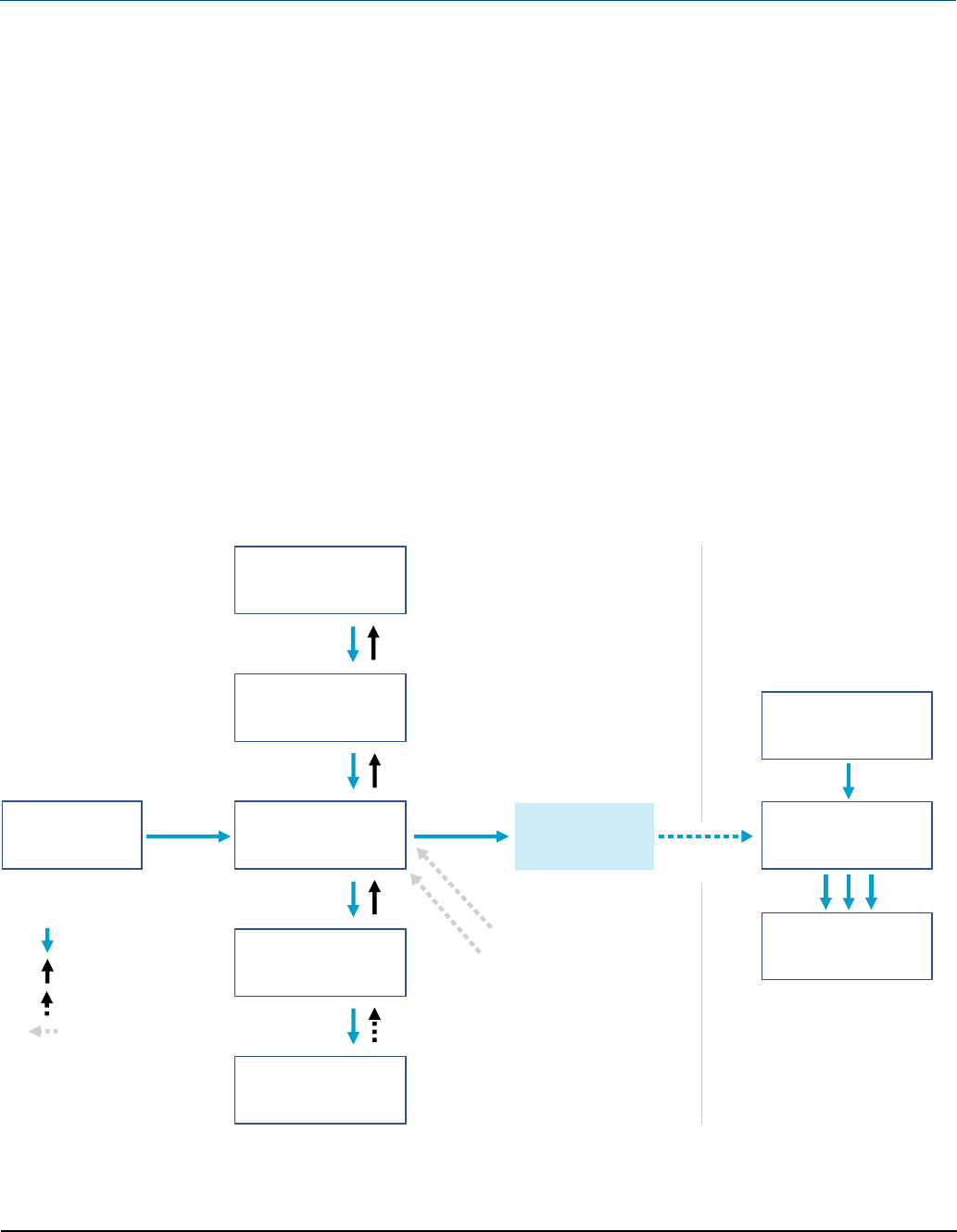
Case Study
BELIZE BLUE BONDS FOR
OCEAN CONSER
VATION
© Alejandro Velasco/TNC Photo Contest

CS SUD: BI DB CONSION O MIN CONSION | 1
Executive Summary
In November 2021, The Nature Conservancy (TNC) and the
Government of Belize (Belize) announced the completion of
a USD 364 million debt conversion for marine conservation
that reduced Belize’s debt by 12 percent of GDP, created
long-term sustainable financing for conservation, and
locked in commitment to protect 30% of Belize’s ocean, in
addition to a range of other conservation measures. The
transaction is the world’s largest debt refinancing for ocean
conservation to date.
The debt conversion enabled Belize to repurchase USD
553 million, a quarter of the country’s total public debt,
from bondholders at a 45% discount through a “Blue
Loan” arranged by TNC. The “debt conversion” resulted in
a USD 189 million reduction in principal outstanding. The
savings achieved in the refinancing allowed Belize to create
an estimated USD 180 million in conservation funding over
20 years, composed of annual cashflows from the govern-
ment and an endowment capitalized through the Blue Loan.
As part of the transaction, Belize committed to ocean con-
servation undertakings, including placing 30% of its ocean,
including parts of the Mesoamerican Reef, under protec-
tion by 2026, using a transparent, participatory Marine
Spatial Planning process, and establishing an independent
Conservation Fund to allocate the conservation funding to
in-country partners.
The financial transaction was arranged by NatureVest,
TNC’s impact investment unit, in support of TNC’s Blue
Bonds for Ocean Conservation strategy. Credit Suisse
arranged and financed the Blue Bond. The structure
was credit enhanced by the United States International
Development Finance Corporation (DFC) and incorporated
a commercial parametric insurance policy to mitigate the
financial impact of natural disasters.
The transaction was recognized in Environmental Finance’s
2022 Bond Awards, winning the sovereign sustainability
bond of the year and the award for sustainability bond
structure innovation.
Transaction Highlights
Key
Transaction
Components
• Belize repurchased 100% of its
“Superbond” at a 45% discount
• A TNC subsidiary provided the Blue
Loan to finance the repurchase
• DFC provided Political Risk Insurance
wrap on Blue Loan
• Credit Suisse financed the Blue Bonds,
which funded the TNC subsidiary to
make the Blue Loan
• Blue Bonds Moody’s rating: Aa2
• Belize committed to achieving marine
conservation targets and using a
portion of the financing savings to fund
conservation over 20 years
Key
Conservation
Impact
• 30% of ocean area under protection
by 2026, half in high biodiversity
protection zones
• Science-based, participatory Marine
Spatial Planning to design protected
areas and ocean management plans
• Creation of a Conservation Fund
Conservation
Finance
• USD 4.2 M per year (on average)
• USD 23.5 M endowment to grow to
USD 92 M (est.) by 2041
Blue Loan
Transaction
• Original Superbond: USD 553 M
• Superbond repurchase price: 0.55c
on dollar
• New Blue Loan: USD 364 M
• Principal reduction: USD 189 M
• Blue Loan IRR: 6.1% (inclusive of
all insurance premiums, fees,
reserves, etc.)
• Maturity extension: 6.5 years

CS SUD: BI DB CONSION O MIN CONSION | 2
How the Transaction Worked
Belize had USD 553 million in a single Eurobond known
as the “Superbond”, as it represented all of Belize’s exter-
nal commercial debt and a quarter of its total debt. The
Superbond was trading at a deep discount (see graphic on
page 3) due to bondholder concerns over Belize’s ability to
pay given an economic slowdown and high debt burden.
As a result of this transaction, Belize was able to source
funding and negotiate the repurchase of the Superbond at
55 cents on the dollar.
Belize could not borrow the funds in the market to pay
the bondholders as the interest rate would have been too
high to create savings. At Belize’s request, TNC arranged
an innovative financial structure, the DFC-insured Blue
Loan between the Belize Blue Investment Company (BBIC)
and Belize, that allowed the country to repurchase the
Superbond. The DFC credit enhancement allowed BBIC to
raise funding from Credit Suisse via the issuance of highly-
rated Blue Bonds and pass through below-market rates
to Belize.
The Superbond refinancing created both immediate
and longer-term fiscal savings for Belize. Belize signed a
Conservation Funding Agreement with BBIC committing to
finance marine conservation eorts over 20 years. These
payments are transferred to an independent Conservation
Fund in Belize and mostly paid in Belizean dollars. Belize
also capitalized an endowment for the Conservation Fund
via borrowing from the Blue Loan. Drawdowns from the
endowment are expected to replicate Belize government’s
payments after year 20 when the Conservation Funding
Agreement expires. Finally, Belize agreed to significant
ocean protection commitments (as discussed in more
detail below).
Government of
Belize
DFC Credit Wrap
Financing
Equity Transfer
in 2041
Blue Bonds (Aa2)
Issuer Loan
Blue Loan
Repurchase
Payment
Repayment
Retirement
Insurance Policy
Superbond
Holders
BBIC
(TNC subsidiary)
Parametric Policy
TNC
Endowment
Blue Bond 1. Blue Loan &
Blue Bond
2. Conservation
Funding Agreement
Investors
Credit Suisse
(via Platinum)
Conservation
Fund
Government of
Belize
Program
Activities
Belize Blue Loan/Blue Bond & Conservation Funding Agreement Structure

CS SUD: BI DB CONSION O MIN CONSION | 3
Background
1 For more see: https://www.nature.org/en-us/what-we-do/our-insights/perspectives/an-audacious-plan-to-save-the-worlds-oceans/
2 Source: S&P Capital IQ
TNC is the world’s largest conservation organization
currently working in over 70 countries with a mission to
conserve the lands and waters upon which all life depends.
TNC’s Blue Bonds for Ocean Conservation Strategy works with
countries to refinance a portion of their national debt to
reduce debt burden, use the savings to secure funding for
conservation activities, and allow countries to achieve their
conservation goals.
1
The strategy targets commitments for
600,000 km
2
of new ocean protection and 4 million km
2
under improved ocean management. The strategy also
seeks to leverage approximately USD 40 to 60 million in
donor support to generate an estimated USD 1.6 billion
in marine conservation finance. The strategy consists of
multiple integrated parts:
1. TNC works with countries to identify their conservation
commitment goals including a timebound plan to put
30% of its ocean areas, including coral reefs, seagrass
beds, mangroves, and other important marine habitats,
under protection
2. TNC arranges the debt conversion that refinances
debt on better terms to create savings to convert into
conservation finance and monitors repayments of the
new loan
3. TNC helps countries create a Marine Spatial Plan work-
ing with stakeholders to identify activities that combine
conservation and sustainable economic opportunities
4. TNC works with local stakeholders to lead the design
and establishment of an independent Conservation
Fund to disburse the funding to conservation partners
and programs
The relationship between Belize and TNC has spanned three
decades, including TNC’s first Debt for Nature Swap in 2001
protecting 23,000 acres of forest and the recent purchase of
236,000 acres of the Selva Maya’s tropical forest in north-
western Belize. TNC’s history in Belize is built on strong
partnerships with Government, NGOs, communities, and
the private sector with a shared vision for sustainable man-
agement and protection of the country’s natural resources.
These partnerships include the development of sustainable
fisheries and mariculture programs and innovative financing
mechanisms though carbon development programs.
The Belize economy, heavily dependent on tourism and
hard hit by the Covid-19 global slowdown, contracted by
16.7% in 2020 and the debt equaled 133% of GDP. Belize
was in negotiations with bondholders to defer payments on
the Superbond, which was trading between 38-47 cents on
the dollar. Given these factors, the Government of Belize
initially started discussions with TNC on refinancing the
Superbond in mid-2020 but discontinued. After a pause
around the national elections in late 2020, Belize restarted
discussions with TNC and, upon extensive negotiations
with TNC and the external commercial bondholders, the
transaction successfully closed in early November 2021.
Belize Superbond 2034 Historical Price and Yield through Retirement
2
0
10
20
30
40
50
60
70
Aug 19 Nov 19 Feb 20 May 20 Aug-20 Nov 20 Feb 21 May 21 Aug 21 Nov 21
Yield
Price

CS SUD: BI DB CONSION O MIN CONSION | 4
Financial Results of the Debt Conversion
Debt Benefits:
» USD 189 million debt stock reduction: USD 553 million
(Superbond) refinanced into USD 364 million (Blue Loan)
» USD 200 million total debt service reduction over 20
years (USD 53.6 million debt service reduction over
initial five years)
» Avoidance of a USD 58.4 million principal
reinstatement—part of agreement from previous
Superbond restructuring that would add back the
negotiated haircut in a default
» 6.5 year extension of debt tenor; increase in weighted-
average life of 3.7 years
» Standard & Poor’s upgrade of Belize’s unsecured foreign
currency credit rating from Selective Default to B- post
refinancing
Conservation Finance Benefits:
» USD 180 million (estimated) of Conservation Financing
created over 20 years comprised of:
• USD 84 million for conservation finance over 20 years;
USD 4.2 million (annual average)
• USD 23.45 million pre-funded endowment, borrowed
by Belize through the Blue Loan
• USD 71 million in anticipated market return (estimated
at 7% annually) over 20 years
» Creation of an independent Conservation Fund to
manage conservation funding
Conservation Commitments
As part of the transaction, Belize, with the support of TNC,
committed to implement pre-defined ocean conservation
milestones. The milestones are time-bound and delays in
achieving the commitments will result in increased pay-
ments under the Conservation Funding Agreement. The key
conservation commitments are:
» Increase in Biodiversity Protection Zones from 15.9%
to 30% of ocean area by 2026—half in high protection
areas (Replenishment Zones) and half in medium
protection areas (Multi-use Zones)
» Completion of a Marine Spatial Plan by 2026 (initiated
in 2022)
3
For full list see: https://www.nature.org/en-us/about-us/where-we-work/latin-america/belize/belize-blue-bond/
» Protection of the public lands within the Belize Barrier
Reef Reserve System, a UNESCO World Heritage Site, as
mangrove reserves
» Revision and implementation of Belize’s Integrated
Coastal Zone Management Plan to include marine and
coastal biodiversity osets
» Application for three formally designated marine
protected areas as International Union for Conservation
of Nature (IUCN) Green List Areas
» Other (non-legally binding) conservation commitments,
including creation of a national blue carbon policy
framework, regulatory framework for high value,
sustainable aquaculture, mariculture, as well as a
governance framework for domestic and high seas
fisheries consistent with transparent, science based,
socially responsible international best practices
3
Marine Spatial Plan
TNC will facilitate Belize’s undertaking of a stakeholder-
driven Marine Spatial Plan. The plan will determine
where to expand ocean protection and management to
cover 30% of Belize’s oceans and best deliver benefits to
people, livelihoods, and biodiversity. This process involves
stakeholders representing local communities, fishing
associations, tourism businesses and government ocials
and uses a transparent and science-based framework
to guide planning. Stakeholder engagement is critical to
ensure that the Marine Spatial Plan will sustainably support
the country’s economy while protecting marine habitats.
Conservation Fund
TNC will help establish an independent Conservation
Fund in Belize to disburse funding generated through the
Conservation Funding Agreement (and potential future
sources). The funds will go to projects and partners
working in Belize to achieve conservation outcomes that
are in alignment with the conservation commitments and
Belize’s national conservation priorities. Both government
and non-governmental actors, including non-profit
organizations, civil society, academia, and the private sector,
shall be eligible to apply for funding. A funding allocation
will be earmarked for the government in support of the
conservation commitments. The Conservation Fund will be
established in 2022 pursuant to an extensive stakeholder
engagement process coordinated in collaboration with the
Ministry of Blue Economy & Civil Aviation. The fund will

CS SUD: BI DB CONSION O MIN CONSION | 5
have a Board of nine directors appointed from government
and the non-government sectors (academia, fisheries,
tourism, and NGOs) and at all times will be an independent
legal entity with a majority non-government representation.
The Transaction Structure
The transaction had two key pillars: 1. the debt conversion
(centered on the Blue Loan) used to finance Belize for the
repurchase and retirement of the Superbond, and 2. the
conservation financing (based on the Conservation Funding
Agreement) committing Belize to long-term conservation
financing to the Conservation Fund and adherence to the con-
servation commitments. The Blue Loan and the Conservation
Funding Agreement have cross-default provisions.
The Debt Conversion
The debt conversion structure is a series of back-to-back
financial transactions, including the Blue Loan and Blue
Bonds, as displayed in the graphic below. To facilitate
the transaction, TNC formed a subsidiary called BBIC (a
Delaware limited liability company) to act as the lender of
record of the Blue Loan. BBIC wrote the Blue Loan to Belize
to finance the purchase and retirement of the Superbond in
full. Credit Suisse fully financed BBIC via the issuance of the
Blue Bonds by a repackaging vehicle (Platinum) which Credit
Suisse syndicated to institutional investors post-closing.
Debt Conversion Transaction Diagram
4 https://www.moodys.com/research/Moodys-assigns-a-definitive-Aa2-rating-to-Platinums-Blue-Bonds--PR_457728
BBIC provided USD 364 million to the Government of Belize
via the Blue Loan with the retirement of the Superbond
as the primary use of funds. In addition, the Blue Loan
financed the Conservation Fund’s initial endowment, a debt
service reserve account, and certain transaction costs.
Components of the $364 million Blue Loan financing:
USD 301 million
Retirement of the $553 million
Superbond at ~55 cents/dollar
USD 24 million
Prefunded Conservation Fund
endowment
USD 39 million
Liquidity reserves, transaction costs,
and original issue discount
The Blue Loan was issued with an original issue discount
and a step-up semi-annual coupon shown in the table below.
The step-up coupon and discount structure reduced the
near-term debt payments to align with Belize’s debt sustain-
ability strategy. The tenor of the amortizing loan is 19 years
with a grace period of principal payments of 10 years.
Blue Loan Step-up Coupon Schedule:
Date
April
2022
April
2023
April
2024
April
2026
onward
Coupon
Rate
3.0% 3.55% 5.15% 6.04%
The DFC political risk insurance covers Belize’s payment of
the Blue Loan to BBIC. BBIC also holds the parametric insur-
ance policy (see below). Credit Suisse solely financed BBIC,
with a loan of USD 364 million, via a repackaging vehicle
(Platinum) which issued RegS/144A Blue Bonds. Due to
the DFC credit enhancement of the Blue Loan, coupled with
the back-to-back legal structure, funded reserve accounts,
and other enhancements, the Blue Bonds received an Aa2
rating from Moody’s Investor Service.
4
Post-closing, Credit
Suisse successfully placed the Blue Bonds with institutional
investors globally. The syndication received high interest
from investors and was multiple times oversubscribed.
TNC supported the transaction through equity funding
to its subsidiary that covered part of the liquidity reserve
requirements. The TNC participation is covered under the
DFC’s Political Risk Insurance policy.
Government of
Belize
DFC Credit Wrap
Financing
Blue Bonds (Aa2)
Issuer Loan
Blue Loan
Repurchase
Payment
Repayment
Retirement
Insurance Policy
Superbond
Holders
BBIC
(TNC subsidiary)
Parametric Policy
TNC
Equity
Endowment
Blue Bond
Investors
Credit Suisse
(via Platinum)

CS SUD: BI DB CONSION O MIN CONSION | 6
Political Risk Insurance
The Blue Loan is covered by a DFC political risk insurance
policy covering “non-payment of an arbitral award” and
“denial of justice”. Belize and TNC agreed to arbitration under
the International Chamber of Commerce’s expedited proce-
dure provision. Belize became a signatory of the New York
Convention in March 2021, which was necessary to ensure
enforceability of an arbitral award. As DFC is the develop-
ment finance institution of the United States government,
the policy is supported by the full faith and credit of the
United States. The DFC policy covers 100% of an arbitration
award arising from loan default and was heavily supported
by private market reinsurers organized by Alliant Insurance
Services. The structure has a 24-month debt service reserve
account, consisting of part cash and part investments, to
ensure Blue Bond interest payments and legal and other fixed
costs will be met during the arbitration process.
The political risk insurance cover, supported by the exten-
sive reserve accounts, facilitated the Moody’s Aa2 rating
for the transaction compared to Belize’s sovereign rating of
Caa3 at the time (a 16 notch rating upgrade).
Parametric Catastrophic Insurance
The Blue Loan structure incorporates the world’s first com-
mercial sovereign debt catastrophe insurance cover. The
Belize economy is highly exposed to economic slowdown
and reduced government revenues resulting from hurri-
canes and large storms. The parametric insurance policy
provides coverage for a Blue Loan debt payment (coupon
and principal) following an eligible hurricane event in Belize.
The payment can be triggered in several ways: 1) based on
the intensity of the hurricane (minimum of Category 3) and
proximity to economic hubs—meaning larger storms can
be further away and still trigger payment; 2) the occurrence
of two hurricanes of any intensity in the same 12-month
period; or, 3) a hurricane of any intensity accompanied
by very heavy rainfall. The policy was designed by Willis
Towers & Watson and underwritten by a subsidiary of
Munich Re. The initial insurance policy covers up to May
2024 (and is expected to be rolled forward over time).
Conservation Funding Agreement
Belize committed to channel a portion of the savings
from the transaction into long-term financing for marine
conservation via the Conservation Funding Agreement.
The 20-year agreement, signed between Belize and TNC,
creates financing to defray the cost of implementing the
conservation commitments. Belize will pay an average of
USD 4.2 million equivalent in local currency per year to the
Conservation Fund. The funds will be disbursed as grants
to government agencies, NGOs, and local businesses and
partners working on marine conservation and related “blue
economy” projects. This agreement more than triples the
pre-transaction government budget allocated to marine
conservation.
Conservation Funding Agreement
The USD 23.5 million pre-funded endowment, capitalized
through the Blue Loan, will ensure funding for conserva-
tion activities after the Conservation Funding Agreement
expires. Assuming a 7% annual return on investment, the
endowment will grow to over USD 90 million by the end
of 20 years. The annual flows plus the ending value of
the endowment create an estimated USD 180 million for
marine conservation over 20 years.
The Conservation Funding Agreement has a cross-de-
fault provision with the Blue Loan. If Belize does not meet
its payment obligations, both the Conservation Funding
Agreement and the Blue Loan will enter into default.
The government’s conservation commitments are covered
in the Conservation Funding Agreement. If Belize does not
achieve a conservation milestones by the agreed date (and
additional grace period), the annual conservation pay-
ment will increase by USD 1.25 million per year for the first
missed milestone and an additional USD 250,000 for each
additional missed milestone.
Conservation
Fund
Government of
Belize
Program
Activities
Endowment
transfer in 2041

CS SUD: BI DB CONSION O MIN CONSION | 7
Innovation
This transaction is a replicable model for achieving con-
servation and climate outputs and creating sustainable
conservation funding. The transaction was innovative in
several ways:
1. Refinancing of Sovereign Commercial Debt at Scale:
The transaction proved that debt conversions for con-
servation and climate can be accomplished targeting
commercial debt at scale. Previous Debt for Nature
Swaps were mostly small (typically less than USD 50
million) and refinanced bilateral (government-to-gov-
ernment) lending. The Belize debt conversion
refinanced external commercial debt—often the most
expensive and burdensome debt for a country due to
higher interest rates. This product allows countries
to take advantage of discounts available in the capital
market and therefore does not require negotiating
write-os from ocial bilateral creditors. This trans-
action adds another tool to the conservation finance
toolbox.
2. Use of Debt Conversion for Conservation to Assist
Debt Sustainability: The IMF stated that the debt
conversion was one of two key reasons Belize made
“significant progress towards restoring debt sustain-
ability in 2021.”
5
While the IMF also stated that Belize’s
debt would remain unsustainable “in the absence of
additional measures”, the debt conversion reduced the
public debt by 12 percent of GDP and helps support the
Belize fiscal strategy, mapped out in its Medium-Term
Recovery Plan, seeking to reduce public debt to 85
percent of GDP in 2025. The conservation flows, which
absent the transaction would have been paid to exter-
nal creditors in USD, will be paid in local currency and
recirculated back into the local economy creating much
needed economic stimulus.
3. Use of Political Risk Insurance: The transaction was
the first structure to utilize the combination of Arbitral
Award Default and Denial of Justice policies from
DFC for environmental protection and conservation
financing.
4. Investor Class Substitution: The DFC credit enhance-
ment facilitated the Aa2 Moody’s credit rating on the
Blue Bonds which allowed Credit Suisse to place the
bonds with institutional investors seeking low risk
assets. The investor market for Aa2 paper, consisting
5 Belize: Sta Concluding Statement of the 2022 Article IV Mission, IMF. February 24, 2022.
6 Belize: Sta Concluding Statement of the 2022 Article IV Mission, IMF. February 24, 2022.
7 University of Cambridge Institute for Sustainability Leadership (CISL, 2021). Risk Sharing in the Climate Emergency: Financial regulation for a
resilient, net zero, just transition. https://www.cisl.cam.ac.uk/news/new-report-calls-risk-sharing-be-expanded-urgently-response-climate-emergency
of global insurance companies, pension funds, high-
net-worth individuals, asset managers, is significantly
larger than the (distressed) emerging market bond
market. This larger investor pool has strong demand
for Environmental, Social, and Governance (ESG) linked
bonds. Moving from distressed high-yield investors
to the Aa2 segment allows for the identification of
investors with the highest ESG appetite to lower the
cost of borrowing, which in turn unlocks more funding
for conservation.
5. New Method of ESG Verification: The involvement
of TNC in multiple aspects of the transaction pro-
vides high-level comfort to Blue Bond investors and
credit enhancers seeking verification of ESG outputs.
Investors require verification that the conservation
promised from Blue Bonds, and similar instruments
such as Green Bonds and Sustainability Linked Bonds,
will be achieved and that the sustainability achieve-
ments will be properly audited and reported. The
involvement of TNC in the project (arranging the debt,
negotiating the conservation commitments, leading the
marine spatial planning, establishing the Conservation
Fund, monitoring and reporting on the conservation
milestone achievements, enforcing any fees on missed
milestones, etc.) for the full 20 years provides a very
high level of comfort that conservation outcomes will
be achieved. Separately, as the structure is based on
existing bondholders’ exit of positions, a mechanism
to acknowledge and certify a seller’s role in an ESG
transaction could increase motivation to participate in
the tender process.
6. Commercial Parametric Insurance: The transaction
introduced the first use of commercial catastrophe
insurance for a sovereign debt issue. Unlike provi-
sions found in some Caribbean sovereign bonds that
allow sovereign borrowers to defer bond payments in
the event of a natural disaster, this policy allows the
government to maintain the original debt repayment
schedule. The parametric insurance directly addresses
the IMF warning that natural disasters present a key
risk to Belize.
6
Moreover, the inclusion of the paramet-
ric cover follows recent market guidance to integrate
climate insurance products into sovereign debt issu-
ances to improve financial management.
7

CS SUD: BI DB CONSION O MIN CONSION | 8
Scalability/Replicability
The TNC debt conversion structure is highly scalable and
replicable. Transaction sizes and overall market are limited
by three criteria:
1. Countries committed to achieving the conservation
outcomes: as the threat of climate change and aware-
ness of the role that natural resources and biodiversity
play in economic growth rapidly increase, most devel-
oping countries will require additional financing for
conservation.
2. Availability and aordability of credit enhancement:
DFC can replicate the insurance structure in other
countries and other bilateral and multilateral develop-
ment finance institutions can consider providing similar
risk mitigation products (e.g., credit guarantees) to do
more deals in more markets.
3. Availability of debt to refinance: while debt conversions
work well with sovereign debt trading at a discount in
the capital markets, they are not exclusively for coun-
tries threatened by high debt distress. Many countries
have high-coupon bonds. Even if these trade at little
to no discount, they can still be refinanced with lower
coupons and longer tenors to create significant funding
for conservation. Many also have commercial bank
loans (or other liabilities) that, while not often traded in
the market, have high interest rates and/or short ten-
ors that may be candidates for refinancing into a lower
interest rate and/or longer tenor loans.
Transaction Participants
This transaction was made possible through the strong
collaboration of many participants. A special thanks is due
to all partner organizations/entities and the many individu-
als who committed their time, energy, and resources to see
this through to fruition.
Philanthropy is instrumental in supporting innovative debt
strategies and allowing TNC to help countries access
millions of dollars in long-term funding for conservation.
Donors who made TNC’s Blue Bonds strategy possi-
ble include: Becht Family Charitable Trust, Oceans 5,
MacKenzie Scott, TED Audacious Project, Je and Laurie
Ubben, and Wyss Foundation.
ROLE ENTITY
Deal Arranger The Nature Conservancy through NatureVest
Debtor Government of Belize
Blue Loan Lender Belize Blue Investment Company, LLC, a limited liability company subsidiary of TNC
Blue Bond Arranger & Funder Credit Suisse International
Political Risk Insurance Provider U.S. International Development Finance Corporation with approximately half of total
exposure reinsured by private insurers: AXA XL, Chubb, Fidelis, Sovereign, and others.
Insurance Broker: Alliant Insurance Services
Parametric Insurance Provider Munich Re (via Great Lakes Insurance SE)
Policy Design & Insurance Broker: Willis Towers Watson
Legal Advisors to TNC Shearman & Sterling; Ropes & Gray; DLA Piper; and Barrow & Co., LLP
Sovereign Debt Advisor to TNC Potomac Group
